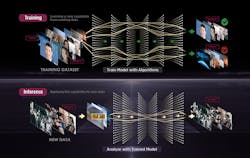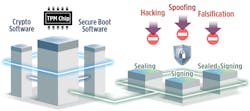Powering Deep Learning and Inference Analysis in Heavy Industrial Applications
Edge computing ups the ante for “faster, smarter, better” IoT. It brings technology and processing close to where data is generated from IoT sensors—and rugged edge computing advances this strategy into more challenging physical surroundings.
Environments that are unstable, uncontrolled, and operating in stark contrast to a data-center structure rely on advanced software algorithms to deliver intelligence and accuracy beyond human capabilities or pace. These industries face an increasing need for specialized hardware that can run algorithms efficiently and consolidate real-time workloads that matter most, those that provide action for improved automation in heavy industrial applications to achieve autonomy with data and localized processing.
Most intelligent software algorithms—the foundation of industrial AI and machine learning—run at an extremely lean level. Efficiency here is crucial to real-time decision-making and requires hardware that works in partnership to deliver processing performance and reliability.
Unlock AI and Predictive Analytics with Smart Hardware Strategies
Rugged, high-performance systems must first and foremost enable reliable deployment in the most severe physical settings. From external enclosure to internal components, every element of a rugged edge computer must be purpose-built through a blend of mechanical and thermal engineering to address environmental issues such as strong vibration, harsh temperatures, and the presence of moisture or dirt.
These industrial-grade computers also need to be validated to execute functions with extreme processing power and storage capacity, designed to eliminate downtime, and ensure stable 24/7 operation. By focusing on enabling software performance with smart hardware strategies, heavy industrial operations are gaining new and greater access to real-time decision-making, powered by fast, predictive analytics at or near the data source.
Data is the New Gold, But Only if You Can Access It
Smart IoT applications generate more and more data, which means smarter data management and access are crucial to increasing automation and streamlining control. This can be demonstrated via an autonomous fleet routing application, as it relies on a wealth of data provided by various sensors that indicate what’s happening in real-time. In addition to increasing vehicle efficiency and safety, these data sources are instrumental in vehicle tracking, routing, reporting, and even monitoring the need for vehicle service.
For instance, in a proof of concept, an autonomously driven truck captures data on its route from point A to point B via a range of sensors deployed in the vehicle, such as cameras, LiDAR, and radar, communicating through standards like the CAN bus. Data is collected and aggregated, then offloaded from the system for further analysis or more robust deep machine learning. Smart algorithms use this data to train the car to become more intelligent and safer, leveraging rugged edge systems as data-aggregation devices that facilitate the vehicle’s neural-network training (Fig. 1).
This type of inference computing recognizes that a four-legged object is crossing the road, likely a dog, by relying on powerful processing near the edge, where it can inform critical decisions in real-time. Hardware must be explicitly designed for performance in the context of mission-critical mobile computing rigors, featuring powerful multicore CPU/GPU processing, high bandwidth, low latency, and seamless connectivity. Passive cooling design is key, enabling systems to operate in extreme temperatures, along with resistance to shock and vibration, as well as support wide-voltage power protection for vehicle batteries.
These rugged edge designs offer even higher value by ensuring continuous wireless mobile connectivity via Wi-Fi and 4G/LTE connections with SIM module sockets for seamless connectivity from tower to the entire fleet network. The system plays an essential role in fleet management through integration with vehicle CAN bus communication protocols.
Critical data, such as vehicle telematics, GPS, and speed, are consistently transmitted while scheduling information and safety data, such as rail conditions or track obstructions, are simultaneously received. Large and ruggedized storage capacity is ideal for long-haul driving data, including a 10-GbE bandwidth connection to move data bidirectionally—effectively stored and accessible to continuously train machine-learning algorithms for ongoing improvement.
Advanced Automation Everywhere is the Future
Applications like high-speed automation, defect detection and prevention, and image recognition all work in an ecosystem where machines become more human-like in their capabilities—only faster and more accurate through intelligent training. Computer vision itself now offers both vision technology and cognitive machine-learning processing power, available right where the data is generated. Run by intelligent software algorithms, these applications ingest and apply images much like a human brain.
Rugged, high-performance systems are necessary to enable smart “object detection” software to process complex visual tasks more efficiently than the human eye. In addition to software algorithms, these systems include programmed sensors and both CPU and GPU computing power capable of analyzing images at high speed.
Faster computational power in x86 processors and advanced real-time graphics accelerators deliver results quicker and more accurately than plant personnel. Consider that perhaps 25% of thousands of images may represent a processing defect. Uncovering these errors in real-time is a significant business advantage, resulting directly from smarter automation and workload consolidation.
Purpose-Built Systems Redefine Industrial Automation
AI, IoT, and connectivity work together to enhance safety and performance, monitor and resolve maintenance issues, and ensure that facilities run based on top-notch efficiency and safety. In this optimized industrial computing environment, data flow is crucial to the success of cyber-physical systems (CPS). The often comprise closed loops that connect embedded computers, communication networks, and physical sensors to create fault-free control systems.
Based on their inherently intensive connection between machines and data, as well as their role in simultaneously generating, accessing, and using data in real-time, CPS deployments demand proximity to the data source itself. Yet systems are often constrained by the rigors of their physical environment and highly sensitive to latency, bandwidth, and reliability issues. These factors perfectly define the need for rugged edge computing, purpose-built to handle artificial intelligence and machine learning in harsh physical settings.
In a CPS deployment via a rugged edge system, the IT infrastructure moves closer to the operational level, allowing operational intelligence and machine learning to power real-time decision-making. Intelligent machines can then work independently of humans, leaving their mortal counterparts to handle more strategic business operations.
Such values apply to a spectrum of applications like automatic product line inspection, intelligent security surveillance, biomedical imaging, vision-guided robotics/vehicles, and much more. Costs are reduced and safety is increased; values powered by smarter, real-time data insights that tap into scalable processing and graphics performance on a ruggedized hardware platform.
System-Level Advances Drive Next-Gen Rugged Design
Fanless rugged edge systems incorporate powerful multicore processors with low-power options and small process architectures. Support for Intel’s 8th and 9th generation Core processors balances performance and thermal regulation for maximum reliability.
Ideally, CPU, GPU, and VPU support is blended to accommodate machine learning and inference requirements at the edge, as dictated by specific application workloads, further enabled by fast 10-GbE connectivity and wireless data-communication options such as Bluetooth, Wi-Fi, and cellular 4G LTE technologies. Along with faster storage drives, these performance accelerators allow for real-time local processing without dependence on cloud technology, eliminating the bottlenecks from pass-through of unwieldy big-data sets.
Next-generation rugged edge systems capitalize on NVM Express, or Non-Volatile Memory Express (NVMe), a proven data-center protocol that also benefits edge workloads. NVMe was designed from the ground up to capitalize on high-speed storage media like NAND or persistent memory via the PCIe interface.
Addressing the limitations of PCIe solid-state disks (SSDs), NVMe executes data transfers six times as fast as SATA III 6 Gb/s by connecting directly to the CPU via the PCIe Gen 3 protocol (Fig. 2). CPU cycles are streamlined as data traverses parallel, low-latency paths in an architecture similar to a high-performance processor.
Reduced latency increases read/write capabilities and IOPs of throughput, enabling the scalable performance required for reflexive inference analysis at the edge. NVMe also enhances system ruggedness, storing data in flash memory with no moving parts and ensuring effective power management with integrated features to regulate SSD power performance.
Hardware-Based Security Elevates Critical Protection of Real-Time Data
When talking about the rugged edge, hardware-based security features must be embedded via TPM 2.0 hardware security, with cryptographic keys used to shield digital data communications between devices from external attacks. These protocols, coupled with edge autonomy, safeguard sensitive data and signals to enable processing without rerouting to less secure cloud resources. This is a critical advantage of rugged edge computing, as machines communicate bidirectionally and data requires constant protection. TPM 2.0 further prevents authentication keys from being exported while recording, as well as autonomous reporting software uploads during the boot process to defend against malware attacks (Fig. 3).
Trusted Computing Group’s (TCG) corresponding Opal 2.0 Storage Specification adds further value for rugged edge systems with high data performance enabled by SSDs. Opal 2.0 enhances the data-storage device’s security features, for example, by defaulting to “always-on” hardware-based encryption, essentially requiring that encryption be applied to stored data. Data at rest can’t be accessed or viewed without proper authorization and decryption, even if a drive was removed, lost, or stolen.
As an advantage over software-based encryption, Opal-compliant drives don’t require host or system support for encryption processes, which instead take place in the SSD itself. This is inherently valuable for rugged edge deployments. Not only is high-performance security present and protecting all data communications and signal transmissions, but these demanding processes are handled effectively and without performance bottlenecks.
Test and Certify Systems Make or Break Viability in Heavy Industrial Settings
Comprehensive design, validation, and certification knowledge of system-level architecture is a key factor in developing these exceptionally robust and dependable computers. Thorough testing and validation for rugged industrial quality is absolutely necessary to support their range of operating temperatures, wide voltage inputs, high shock and vibration, and overall sustainability.
Rigorous environmental testing demands equipment ranging from temperature, humidity, and thermal shock chambers, to vibration and shock tables and signal/EMI integrity testers. Power protection evaluation is also key, given the potential for heavy industrial settings to have routine power fluctuations.
Regulatory certifications and compliance, including CE, FCC, E-Mark, EN50155 (railway specific), and UL (optional), can make or break a rugged edge computer’s viability in a particular scenario. It’s best to adhere to these directives wherever possible for greater utilization in and even across industries.
Data and telemetry for IoT data in the cloud must also be considered. Devices that are Microsoft Azure Certified for IoT are pre-tested for readiness, compatibility, and usability with Microsoft Azure IoT Technology.
Microsoft Azure IoT is a collection of cloud services that connect, monitor, and control IoT assets. All certified devices have hardware and software guaranteed to work with Azure IoT. This ensures that customers will have the confidence to jump-start their IoT projects, saving time and effort during the process.
AWS IoT Greengrass is AWS’s solution for developers requiring a less centralized processing platform for their IoT network. It empowers edge computers to act locally on the data they collect and generate. AWS Greengrass delivers immediacy, autonomy, and security to IoT deployments. End users are poised to access reliability, scalability, and long-term performance in a highly durable system with full-featured connectivity and support for a broad range of data platforms.
The Rugged Edge is Faster, Smarter, and Better
Advanced, rugged edge computers provide the right combination of capabilities and cost, including diverse, high-speed I/O, multicore accelerators, and a graphics engine empowering deep learning and inference analysis at the network edge. Extended product roadmaps ensure system longevity, even as its neural network trains and retrains the system with new data affecting greater efficiency and non-stop improvement.
The most demanding industrial IoT environments are no longer at a computing disadvantage. With specialized hardware, advanced software algorithms are empowered to deliver the intelligence necessary for efficiency and consolidation, facilitating localized data processing for automation in robust industrial applications.



